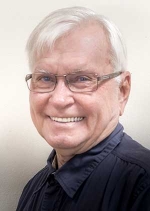|
By Anonymous — Thursday, June 4th, 2020
 Florene Data turned a century-plus-three in May and Fillmore wants to help her celebrate. On Monday, June 8, at noon in front of Fillmore City Hall, come wish Florene a happy birthday! Instead of gifts, please go by a dollar store and pick up something patriotic; a flag, a hat, anything red, white & blue and gift it to her. Florene is famous for driving around Fillmore in her scooter, complete with the American flag flying in the wind as she cruises down Central Avenue. Fillmore's Towne Theatre marquee sends the message we all want to deliver to Florene HAPPY BIRTHDAY! Enlarge Photo |
|
By Anonymous — Thursday, June 4th, 2020
 On Tuesday Afternoon, June 2nd, a group of George Floyd protestors gathered in peaceful demonstration at the corner of Central Avenue and 1st Street in Fillmore. Enlarge Photo |
 Sespe School, which was located on Grand Avenue back in 1890. Photos Courtesy Fillmore Historical Museum. Enlarge Photo By Anonymous — Thursday, June 4th, 2020
 Fillmore Historical Museum does not have photographs of the Sespe School Miss. Smith taught at, but it would have looked similar to the school at Cienega, just east of Fillmore, and both were built around the same time, 1873. Enlarge Photo Courtesy Fillmore Historical Museum This is a verbatim copy of a history of the Sespe Schools, prepared by Clara H. Smith, who taught there in the 1886 -1887 school year. A long time teacher in Ventura County schools, she later taught in the Normal School at San Jose, Calif. She probably wrote this in the 1920s or 1930s. The items in brackets were corrections or clarification prepared by F. L. “Ted” Fairbanks, a resident of Fillmore from 1907 until his death in 1983. Written By Clara Smith The original district known as the West Sespe included the land drained by the Sespe River and its tributaries, and also a portion of the land bordering the Santa Clara River. The eastern and western boundaries were the mountains, the southern boundary was the Santa Clara River. The region consisted of a Mexican land grant. Around the edge of this grant, the white settlers established homes. A school for the white settlers’ children naturally followed. In 1874 or 1875 a schoolhouse was built on the north side of the Santa Clara River near the present site of the bridge crossing from Fillmore to Bardsdale. The builder was a Mr. F. A. Sprague. [This is the man sent to the penitentiary for the murder of T. Wallace More.] His son, Hartley and daughter, Ida, [should be Iva], hauled up the lumber from Ventura with team and wagon, and the father built the school house. The first teacher was a Clara Skinner, followed by Lara Larson. Other teachers were Augusta Stevens, Maude Fisher, Ryal Sparks, and a man names Jordan. The last named showed his individuality by his way of dismissing the children at intermissions. Not the “one, two, three, four”, common in schools of the period, but “Get out of here.” The late Sol Sheridan began his school life in this little pioneer schoolhouse. [Robert M. Sheridan, prominent attorney in Ventura, says this is an error, that Sol Sheridan got all of his schooling in Missouri, before coming west.] The school building was of the prevailing type, a wooden structure, 20 x 30 feet, having three windows on each side. The height of the ceiling varied according to the judgment of different teachers. It is recorded as being 11, 12, and 16 feet. About 1879 or 1880 the schoolhouse was moved from its place on the bank of the Santa Clara River to the east bank of the Sespe River, or creek as it was called. This was about a mile north of the present rail (road) bridge crossing the Sespe. This was to give the school a more central place in the district. Here it stood in utter loneliness with only the roaring of the raging Sespe Creek in the winter, and the silence of the desert surroundings in summer. There were no trees, no shrubs other than the sage brush to break the monotony. A glance inside the door shows a water bucket with a tin dipper standing on the floor surrounded by waste water. The water has been carried up from the creek, and the children quench their thirst until the teacher bans further drinking. A book case to the left of the door houses one hundred fifty volumes, many of which are beyond the ability of children to read. Supplementary reading material was unknown. The children sit in rows facing the teacher, whose chair and desk occupy a place on the platform at the other end of the room. Perchance an unruly child has a desk at her side. To the right of the teacher stands a manikin which shows the relative position of the different organs of the human body. This is the nearest approach to the instruction in hygiene which the children will receive. The three windows on the east side give plenty of heat in the forenoon, and those on the west side continue the warming process after lunch. Here the children of those early settlers learn according to their own abilities, and according to the skill of the teacher. Those whose names appear on the reports of the period are: Goodenough, Japson, Kellogg, Kinney [should be Kenney], Akers, Fine, McIntyre. There are no names of children born of foreign parents. Nor do the census reports show that there are any foreign children in the school. The teachers are employed for eight months at a salary of sixty dollars per month. There is one record of a teacher being employed two years in succession. This honor goes to Miss Anna Persons who afterwards became a member of the Santa Paula School system. She had a record of being a superior teacher. The chief agricultural products of the community were: grain and stock for the market, and grapes, olives, and garden produce for home consumption. It was not unusual for the children to be kept out of school to herd the cattle or to help with the farm work. The railroad was built in 1887. Soon afterwards a water company developed and distributed water from the Sespe. The growing of citrus fruits began. The population increased. Mexicans came to work in the orange and the lemon groves. Three districts were formed out of West Sespe, and three schools were built one further up the canyon was on what is now Grand Avenue. The second was the present San Cayetano and the third was Fillmore. San Cayetano became the school for the Mexican children. Meanwhile the little pioneer school on the banks of the Sespe was moved to Fillmore. For a while it was used for a schoolhouse, when no longer needed, a doctor, J.P. Hinckley bought it and converted it into a drugstore, with a residence in the rear. After more than sixty years of service, it burned. The writer recalls the faith the pioneers of the eighties had in the future of their community. They have passed on, and a few of their children are left to enjoy the fruits of their labor. And to see the marvelous changes that have taken place in this beautiful, fertile, Sespe Valley. Clara H. Smith |
|
By Anonymous — Thursday, June 4th, 2020
PUBLIC HEARING ON THE 2020-21 PROPOSED BUDGET INFORMATION/DISCUSSION Approve Change Order #2 for Fillmore Middle School Baseball/Soccer Field Improvements Project, 543 Approve Submission of Form J-13A, Request for Allowance of Attendance Due to Emergency Approve Contract for Assistant Superintendent, Educational Services Personnel Recommendations Temporary Procedures for Virtual Public Participation in School Board Meetings Next Meeting Dates: Regular Meeting Regular Meeting |
 Photo of the Week: "Canyonlands National Park, Utah" by Bob Crum. Scene from Dead Horse State Park vista. Photo data: Canon 7DMKII, Av mode, Tokina 11-16mm lens with polarizer filter @14mm, ISO 320, aperture f/11, 1/250 second shutter speed. Enlarge Photo By Bob Crum — Thursday, June 4th, 2020
Like rain in a bucket
The menace COVID-19 is taking a toll on my psyche. Others must feel likewise. It's frustrating that there isn't a light at the end of the proverbial tunnel. It's as if the virus is lurking everywhere, ready to ravage any human within striking distance. It's hoped that a resolution is found sooner than later. Thank you writers! So many emails bombarded me that I need shields like those of the Nebulon-B Frigate! Twelve percent (I did the math) of my 2,692,585 readers appear to be incorrigible. So many to reform but try I must. By the way, phonetographers, you might find reading the legals more interesting. Just a thought. One issue in particular (SOOC), has raged since the dawn of the digital photography age. Petapixel penned that many photographers seem to get some sort of “pure as the driven snow” feeling from posting the acronym “SOOC” (Straight Out Of the Camera) next to their digital pics. Yep, the same-old same-old "SOOC" is back! Ugh! Why do I protest? I don't object to the principal. I object to the ignorance of the majority who don't know what "get it right in the camera" really means! They tout that their photo is special because they got it right in the camera, meaning that they didn't have to post-process. That sounds reasonably innocuous so, what's my problem? Well, let's see. Any photographer, with any digital camera in "Auto" mode, can usually get it right (exposure) in the camera. And post the photo on social media with the acronym "SOOC" insinuating: "Look, people, NO post-processing!" Get the smelling salts; I'm getting nauseous. When a photographer creates a photo by programming ISO, aperture and shutter speed for the desired effect, 'properly' composes the image, and captures the photo in focus and didn't require any post-processing, I'll respect his declaration: SOOC. But, not even that photographer can legitimately proclaim that his photo wasn't processed. Oh how I love to nitpick. The photo straight out of the camera was processed by the camera's internal computer according to algorithms programmed by the camera's engineers. The photo is a jpeg that has been compressed considerably, meaning half the original pixels were discarded. So, pure as the driven snow it is not. More importantly, just because a jpeg SOOC of the camera wasn't post-processed doesn't mean that it's a photo that's as good as it could be! It's not! Getting off "auto" mode and shooting manual mode is often intimidating for many photography neophytes. To help you understand the ISO, shutter speed and aperture relationships, I found the following perfect analogy from "cambridgeincolour.com". "Achieving the correct exposure is a lot like collecting rain in a bucket. While the rate of rainfall is uncontrollable, three factors remain under your control: the bucket's width, the duration you leave it in the rain, and the quantity of rain you want to collect. You just need to ensure you don't collect too little ("underexposed"), but that you also don't collect too much ("overexposed"). The key is that there are many different combinations of width, time and quantity that will achieve this. For example, for the same quantity of water, you can get away with less time in the rain if you pick a bucket that's really wide. Alternatively, for the same duration left in the rain, a really narrow bucket can be used as long as you plan on getting by with less water. In photography, the exposure settings of aperture, shutter speed and ISO speed are analogous to the width, time and quantity discussed above. Furthermore, just as the rate of rainfall was beyond your control above, so too is natural light for a photographer." Now, grab your 'bucket' and go photoing! Photo of the week is from my archives: Canyonlands National Park as seen from a Dead Horse State Park vista, Utah. Send comments, suggestions or questions to: focusonphotography@earthlink.net |
|
By Anonymous — Tuesday, June 2nd, 2020
This event is closed to the public. Do Not Attend. Please watch the live stream from home. Thank You. |
|
By Anonymous — Tuesday, June 2nd, 2020
This event is closed to the public. Do Not Attend. Please watch the live stream from home. Thank You. |
 On Tuesday, May 26th at 6:30pm, near the 600 block of Fillmore Street, Fillmore Police received a call regarding the well being of a woman whose son threatened her with a knife. Once on scene Ventura County Fire and AMR Paramedics treated two victims with lacerations to the neck and hands. Both were transported to a nearby hospital. No update on their conditions. Pictures provided by VC News Crew. Enlarge Photo By Anonymous — Wednesday, May 27th, 2020
At 6:30pm on Tuesday evening, May 26, 2020, the Ventura County Sheriff's Department was dispatched to a check the well being call of a person reporting that someone was trying to kill her in the 600 block of Fillmore Street near 2nd Street in Fillmore. As more information came in, a son had allegedly threatened his mother with a knife. The son had reportedly been drinking, and shown a knife to his mother he wanted to assault her with, according to radio traffic. At 6:40pm, Sheriff's deputies who had arrived to the scene requested that Ventura County Fire Department and AMR paramedics respond for a stabbing victim with lacerations to the neck. A second victim with a laceration to the hand was also being reported as being found. Both victims were being transported to the hospital. Their conditions were not available. Information on if a suspect had been found or arrested was not available. Crime Scene Investigations and major crimes detectives were responding to further the investigation. The street was taped off in the area. No further information was available at this time. Courtesy Safety for Citizens Facebook Page. |
|
By Anonymous — Wednesday, May 27th, 2020
The Santa Clara Valley Boys and Girls Club would like to thank SoCalGas for donating $5,000 for new IPADS. SCVBGC CEO Jan Marholin stated, “I personally want to thank Sarita Figueroa and Maria Ventura from SoCalGas for helping us acquire this grant for our youth. So much of the work we do is now driven by IPADS.” Courtesy SCV Boys & Girls Club. |
|
By Anonymous — Wednesday, May 27th, 2020
 Have you noticed a new billboard while entering Fillmore congratulating the Fillmore High School Graduating Class of 2020? The community of Fillmore is proud of their graduating seniors! Enlarge Photo |







